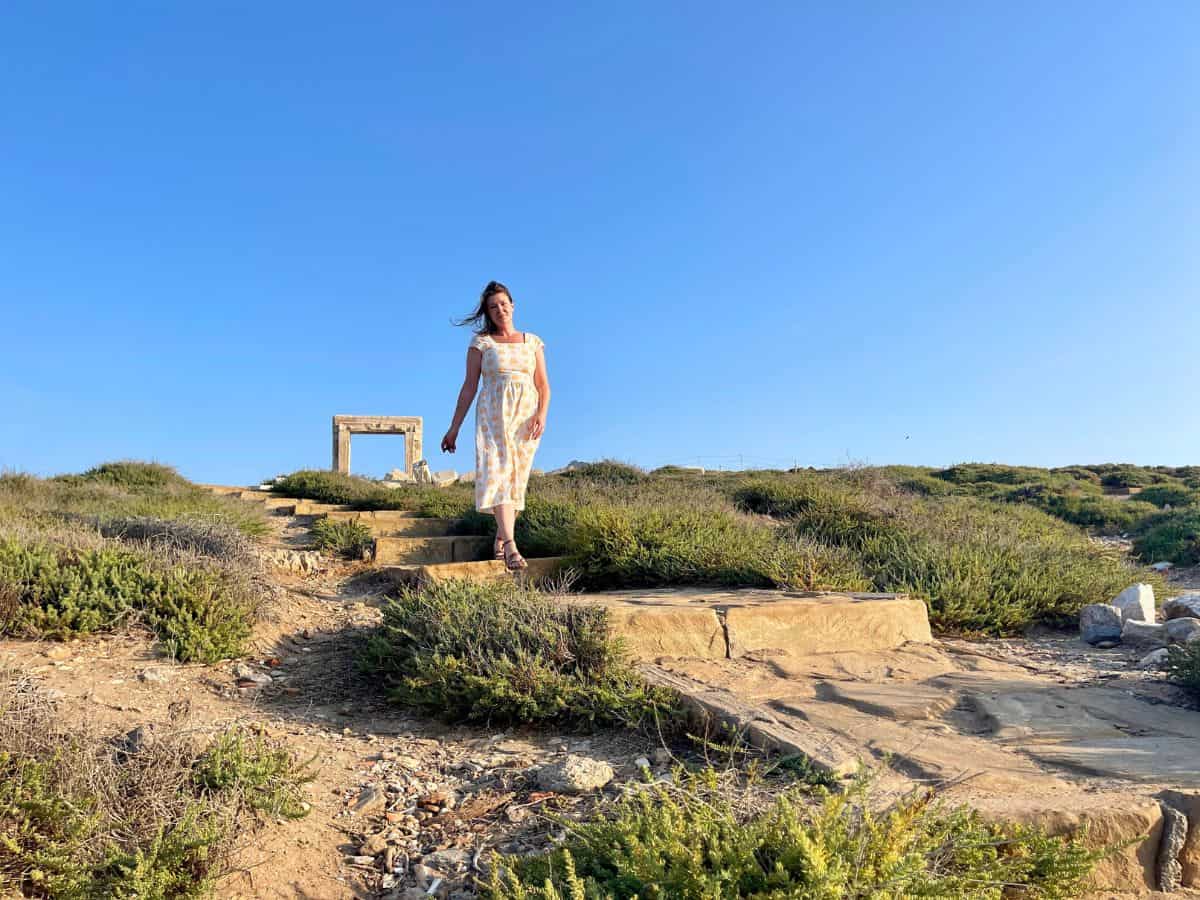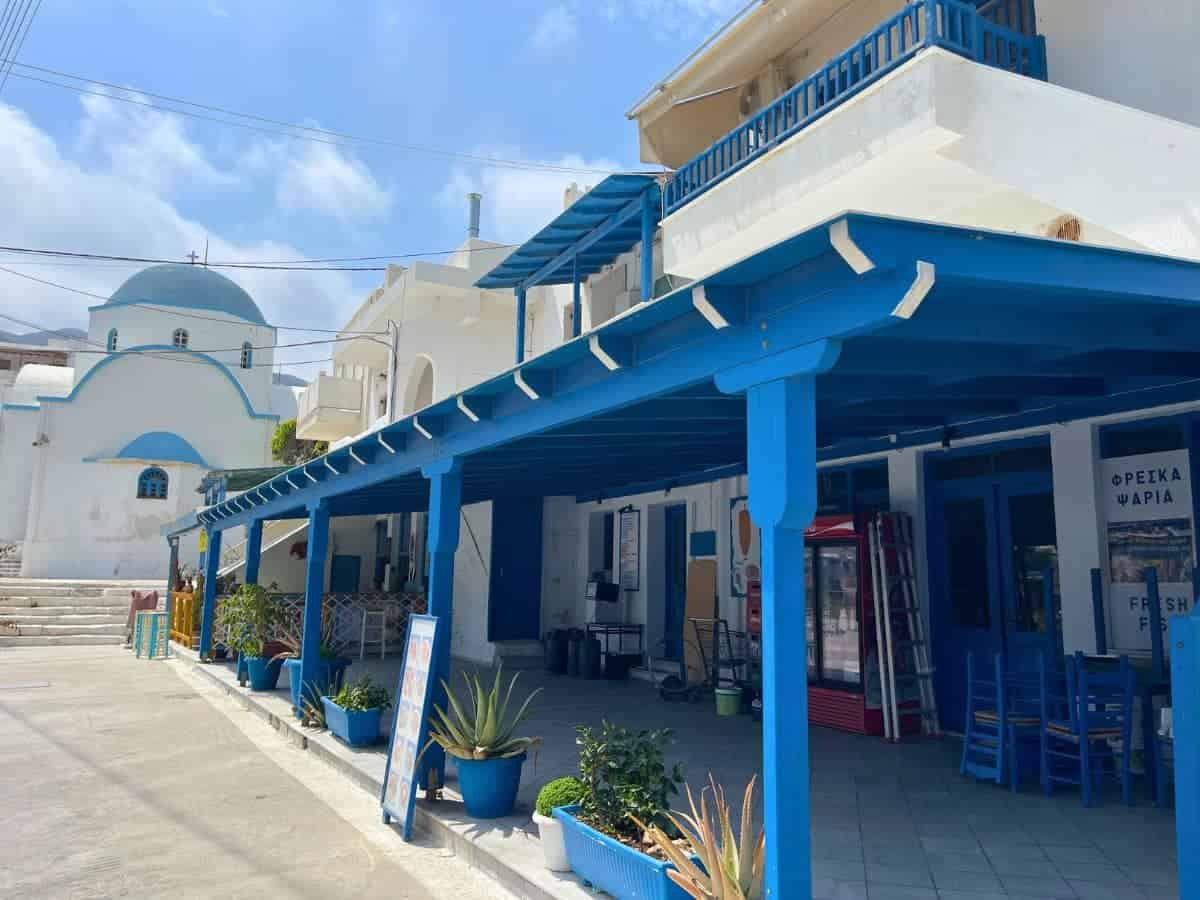A Solo Woman Traveling uses human-written content that contains affiliate links and is a member of Amazon Services LLC. When you make a purchase on a link, we may receive a small commission. This is at no extra cost to you. See Our Affiliate Policy and Advertiser Disclosure for more info.
Looking for the best villages in Naxos? I’ve had the joy of exploring not once, not twice, but three times. I’m kinda obsessed with the Greek Islands if you can’t already tell.
Each visit has only deepened my love for its quaint villages, each one a postcard-perfect snapshot of Greek bliss.
In this fresh 2025 guide, I’m breaking down everything you need to know about these charming villages, where the welcome is warm and the views are legendary.

From the hidden alleyways of Apiranthos to the golden sunsets of Agios Prokopios, my adventures have been rich with discovery, and I’m here to share it all.
QUICK TIP: If you are making a short trip to the Greek island, join a Naxos bus tour! It’s the best way to knock out the main idyllic villages in one day.
What are the MUST-VISIT villages in Naxos?
- Chora (Naxos Town) – The capital, biggest village, and main port of the island, Chora is celebrated for its hilltop castle, winding narrow alleys, and the iconic Portara, part of the Temple of Apollo.
- Apeiranthos – Known as ‘the marble village’, Apeiranthos is distinguished by its marble streets, traditional Cycladic architecture, and its rich cultural heritage showcased in several museums.
- Halki – Halki, a historical capital, is the island’s Kitron production center. Its neoclassical architecture and the Vallindras Distillery offer visitors a taste of the traditional Naxian spirit.
- Filoti – Nestled at the base of Mount Zas, Filoti is the largest main village after Naxos Town and is known for its charming central square, cultural festivals, and beautiful hiking paths.
- Apollonas – A coastal village notable for its laid-back ambiance, Apollonas features a small, delightful beach and is home to an ancient Kouros statue, partially carved from the local marble.
- Koronos – This mountainous village is famous for its narrow, stepped streets, surrounding green valleys, and a history rooted in emery mining.
- Potamia – Comprising three smaller villages, Potamia is a lush, verdant area with abundant water sources, known for its fruit orchards, tranquil atmosphere, and picturesque scenery.
- Agia Anna Village– Closest village to Naxos town with idyllic beaches and public transport to and from!
- Sangri– This village is renowned for its ancient Temple of Demeter and lush, scenic landscapes.
- Melanes– charming village, famed for its ancient statues and verdant valleys offering a glimpse into the island’s rich history and natural beauty.
Downloadable Map of Naxos Villages
Download my pre-pinned Google map of all the best locations in this post!
My favorite restaurants, bars, hotels and top sights are all saved and ready to use!
Need Help Planning Your Trip? Get a customized itinerary!
#1. Naxos Town (Chora)

One of the reasons I love Naxos is because it’s an affordable Greek Island!
The main village in Naxos is called Naxos Town, also referred to as Chora. This is the main hub and where the ferries dock at the port.
Each time I visit Naxos I stay in the main town either in the old town village or near the beach.
Some of the best things to do in Naxos town is simply wandering the alleys lined with boutiques and eateries.
One of the best places to see is the Venetian Castle of Naxos and the museum. It is located on top of the old town. My favorite spot for an evening cocktail about ancient ruins was Avaton 1739!
Where To Stay in Naxos Town: Nastasia Village
Read Next: Should I Rent A Car In Naxos
#2. Apeiranthos
Distance from Naxos Town: 26 km / 16 miles
One of the most beautiful villages in Naxos is Apeiranthos! A fun fact about Apeiranthos is referred to as the marble village as so many of its structures are made from marble.
The drive from Naxos city center to Apeiranthos takes about 40 minutes by car.

Apeiranthos is one of the coolest mountainous villages frozen in time.
It’s a fun place to explore its labyrinthine streets, well-preserved Venetian towers, and stone-paved alleys, this traditional small village exudes an old-world charm.
If you have time, visit the Archaeological Museum, and admire the panoramic scenic views of the surrounding landscape.

Where to Stay in Apeiranthos: Petra Home
#3. Chalki (or Halki)
Distance from Naxos Town: 16 km / 10 miles

Chalki, once the capital of Naxos, is a picturesque village known for its elegant neoclassical mansions and quaint atmosphere.
Take a stroll through the village square, visit the Byzantine church of Panagia Protothroni, and indulge in local products like citrus liqueur and Kitpon (lemon-based liqueur).
Don’t miss the great opportunity to visit the Vallindras Distillery, known for its production of Kitpon. The entry fee is 3 euros, and it’s cash only!

#4. Filoti
Distance from Naxos Town: 18 km / 11 miles
Another tiny village at the foot of Mount Zas, Filoti is a traditional village renowned for its authenticity and natural beauty.

Discover the village’s main square, shaded by plane trees, and savor traditional Greek dishes in the local tavernas.
From Filoti, you can embark on a hike up Mount Zas, the highest peak in the Cyclades, for breathtaking panoramic views of Naxos.
#5. Apollonas
Distance from Naxos Town: 36 km / 22 miles

Apollonas is a charming coastal village located on the northern coast of Naxos.
This small fishing village is nestled amidst stunning natural surroundings. It is super quaint, very small, and the perfect place to spend an afternoon in Naxos.
One of the main highlights of Apollonas is its magnificent beach, which stretches along the coastline, inviting you to relax and soak up the Mediterranean sun.

The sandy shores are lined with sunbeds and umbrellas, providing comfort and shade as you bask in the beauty of the azure sea.
The beach of Apollonas is also known for its colossal statue, the Kouros of Apollonas, which lies partially carved into the rock formation.
This impressive sculpture, dating back to ancient times, stands tall and majestically overlooks the beach, offering a glimpse into the island’s rich history and culture.

The Prettiest Digital Travel Planner
The Notion Travel Planner features 100+ ChatGPT-powered travel prompts, a credit card points tracker, budgeting tools, direct access to 50+ pre-pinned Google Maps from this site, and more—all beautifully organized in one easy-to-use space.
#6. Koronos
Distance from Naxos Town: 28 km / 17 miles
Koronos, a tranquil village tucked away in the mountains, offers a glimpse into traditional rural life in Naxos.
Wander through its narrow streets, adorned with colorful flowers, and visit the Folklore Museum to learn about local customs and traditions.
Enjoy the serene atmosphere and panoramic views of the surrounding valleys and sea.
#7. Potamia
Distance from Naxos Town: 9 km / 6 miles
Located in the heart of the island, Potamia is a collection of three charming villages: Ano Potamia, Mesa Potamia, and Kato Potamia.
Surrounded by lush greenery and flowing streams, these villages offer a refreshing escape from the coastal areas.
Explore the winding paths, visit the Church of Panagia Drosiani, and admire the traditional stone-built houses.
#8. Agia Anna Village

Distance from Naxos Town: 7 km / 4 miles
Nestled on the southwestern coast of Naxos, Agia Anna Village is a picturesque seaside gem.
I loved visiting this small village since it’s so close to Chora and has one of the beach beaches on this side of the island! You can easily take the bus here from Naxos town.
So if you aren’t able to rent a car or visit the other villages on a bus tour, you can come to Agia Anna.
The bus runs from the main bus stop very frequently during the summer months. Check the bus schedule here.
#9. Sangri
Distance from Naxos Town: 12 km / 7 miles
Sangri village in Naxos is a quiet, beautiful place with lots of history, Byzantine churches and nature.
It’s famous for the old Temple of Demeter, a special building from long ago that shows the classic style of the area. The village is also known for its fertile lands and pretty gardens.

Walking around, you’ll see old-style Greek houses and can visit a small museum nearby that tells more about the area’s history.
Sangri is a great spot if you like peaceful places with a mix of nature and history. It’s a nice change from busy tourist spots and worth a visit for a different experience in Naxos.
#10. Melanes
Distance from Naxos Town: 8 km / 4 Miles
Melanes is a village that beautifully intertwines history with nature.
Come here to see the impressive ancient statues, particularly the striking Kouros of Flerio statues, which date back to the 6th century BC, lying unfinished in their original quarries.
This village is a must-visit for those who appreciate historical artifacts set amidst natural beauty, providing a serene escape from the bustling tourist spots.
Find the best rates on rental cars in Naxos here.
How To Visit SEVERAL Charming Naxos Villages in One Day!

The only real way to visit many of these idyllic villages in Naxos is to rent your own car.
A great way to see a number of these villages, specifically, Halki, Apollonas, Apeiranthos, and the Koronos Statue is to take a bus tour. It is the most time-efficient and affordable way to see them.
The bus tour also includes a stop at the Temple of Demeter, unless it’s a Tuesday, then you go to Kouros of Melanes and the Village of Filoti.

❤︎ Click here for a list of all the best hotels on the island of Naxos!
Conclusion: Best Villages in Naxos
There are still more villages to be visited in Naxos, but those are the only I was able to visit and can personally recommend.
I highly advise you to prioritize this list based on your own interests. If you are a slow traveler you will appreciate the time it takes to make a stop at each.
It took me three trips to Naxos to see all these islands so don’t be discouraged if you can’t see them all in one trip!
Have questions? Contact me here!
Planning a trip to the Greek Islands?
Travel Resources for Greece
- Solo Trips to Greece
- Greece Travel Guide
- Ultimate Greece Travel Guide
- 15 Best Greek Islands For Solo Travel
- 9 Best Greek Islands for Foodies & Wine Lovers + Map
- Solo Female Packing List For Greece: Summer & Winter
- The Best Private Airport Transfer From Athens Airport
- Affordable Greek Islands Near Mykonos
- Best & Hottest Greek Islands to Visit in May
- Should You Rent a Car on the Greek Islands?
- Most Reliable Ferry Company For Greek Island Hopping
- Cyclades Islands or Sporades Islands? How to Choose!
Alonissos
Athens
- What To See In 2 Days In Athens Itinerary + Map
- What to Expect Visiting Athens in November
- Is Athens Worth Visiting? Should You Go or Skip It?
- What to Expect When Visiting Athens in December
- 10 Best Athens Hotels With Rooftop Pools
- How To Visit Athens On A Budget + Free Calculator
- 7 Easy Day Trips From Athens City Center
- Best Half-Day Tour: Athens To Temple Of Poseidon
- Coco-Mat Athens BC Hotel Review
- The Best Ferry From Athens To Hydra Island in
- Ultimate Athens Solo Travel Guide + Free Map
- Easy Greek Words and Phrases to Learn for Travel
- Is Your Name Greek? Greek Names Generator & Meanings
- 18 Pros & Cons of Living in Athens Greece by an Expat
- Best Cafes in Athens by Neighborhood
Crete Island
Folegandros
Hydra
Koufonisia
Milos Island
- All The Best Things to Do in Milos By Area + Map
- Renting a Car in Milos: What You Need To Know
- The Perfect 4 Days in Milos Itinerary Guide + Map
- 12 Best Boutique Hotels In Milos Greece in
- A Private Luxury Boat Tour to Kleftiko Milos
- Best Milos to Athens Ferry Travel Guide
- Sifnos vs Milos: Which Island is Better
Mykonos
- Ultimate Solo Travel Guide Mykonos
- Is Mykonos Expensive?
- How to Get Around in Mykonos
- Day Trips From Mykonos
Naxos
- Renting a Car in Naxos: Exploring the Pros and Cons
- Best Naxos Bus Tour Highlights of Idyllic Villages
- 10 Best Villages to Visit in Naxos
Sifnos Island
- Best Guide to Sifnos Greece: Everything To Do + Map
- A Guide to Booking a Ferry From Athens To Sifnos
- Flight From Athens to Sifnos By Private Helicopter
- Honest Review of Nival Boutique Hotel in Sifnos
- Best Beaches in Sifnos, Greece
- Sifnos or Serifos: Which Island is Better?
- Milos or Sifnos: Which Island is Better?
- Sifnos or Syros: A True Comparison
Serifos Island
- Complete Island Guide To Serifos Greece + Map
- Which is Better: Sifnos vs Serifos?
- Serifos or Folegandros: Which Island is Better?
Skiathos & Skopelos
Skopelos or Skiathos, Which Greek Island is Better?
Rhodes & Symi Island
Did you enjoy this article? Help fellow travelers and share this guide with the buttons below!








